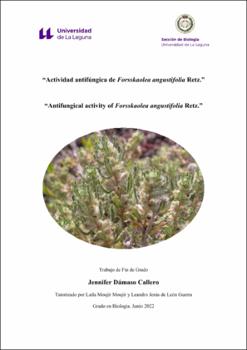Actividad antifúngica de Forsskaolea angustifolia Retz.
Author
Dámaso Callero, JenniferDate
2022Abstract
Most fungal infections are caused by opportunistic pathogens of the Candida
genus: Candida albicans and, the increasingly frequent, Candida no albicans. The
treatment of these infections is limited, on the one hand, by the few clinically useful drugs
available and the side effects that many of them present, and on the other, to the increased
resistance of these yeasts to antifungals. In the search for antimicrobial substances from
natural sources, this work evaluates the antifungal activity against 6 species of the genus
Candida of 8 extracts of Forsskaolea angustifolia (Fam Urticaceae), a plant endemic to
the Canary Islands that is used in popular medicine for the treatment of different
conditions. The yeasts C. krusei, C. parapsilosis and C. albicans showed sensitivity to
the extracts obtained from the roots and leaves at 200 μg/ml. The hexanic extract of leaf
showed a higher activity (C. krusei, MIC50=59 μg/ml) than the hexanic and ethanolic
extracts of the root and the ethyl acetate or aqueous extracts of the leaf (MIC50 between
116 and 195 μg/ml). C. parapsilosis exhibit moderate sensitivity to hexanic root extract
(MIC50=169 μg/ml), while the yeasts C. tropicalis, C. lusitaniae and C. glabrata were
insensitive to F. angustifolia. La mayor parte de las infecciones fúngicas son producidas por patógenos
oportunistas del género Candida: C. albicans y, las cada vez más frecuentes, Candida no
albicans. El tratamiento de estas infecciones se ve limitado, por un lado, por los pocos
fármacos de utilidad clínica disponibles y los efectos secundarios que presentan muchos
de ellos, y por otro, al incremento de la resistencia de estas levaduras a los antifúngicos.
En la búsqueda de sustancias antimicrobianas de fuentes naturales, este trabajo evalúa la
actividad antifúngica frente a 6 especies del género Candida de 8 extractos de
Forsskaolea angustifolia (Fam. Urticaceae), una planta endémica de las Islas Canarias
que es usada en la medicina popular para el tratamiento de diferentes afecciones. Las
levaduras C. krusei, C. parapsilosis y C. albicans fueron las levaduras más sensibles a
los extractos obtenidos de la raíz y las hojas a 200 μg/ml. El extracto en n-hexano de hojas
presento una mayor actividad (C. krusei, CMI50=59 μg/ml) comparado con el hexánico y
etanólico de raíz y de acetato de etilo o acuoso de hoja (C. krusei, CMI50 entre 116 y 195
μg/ml). C. parapsilosis mostró una moderada sensibilidad a la acción del extracto
hexánico de raíz (CMI50=169 μg/ml), mientras que las levaduras C. tropicalis, C.
lusitaniae y C. glabrata fueron insensibles a F. angustifolia.




